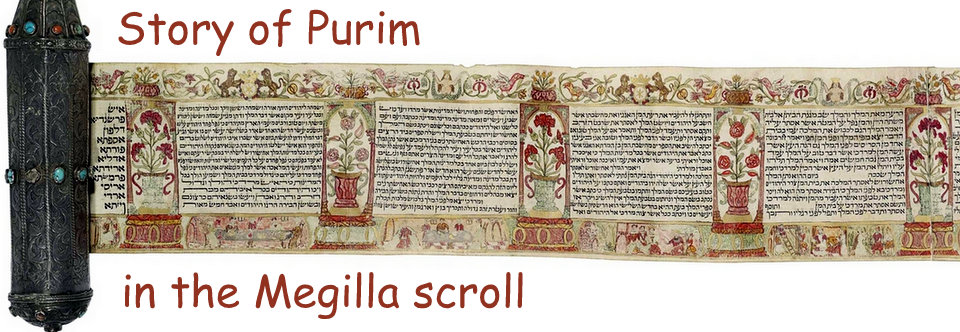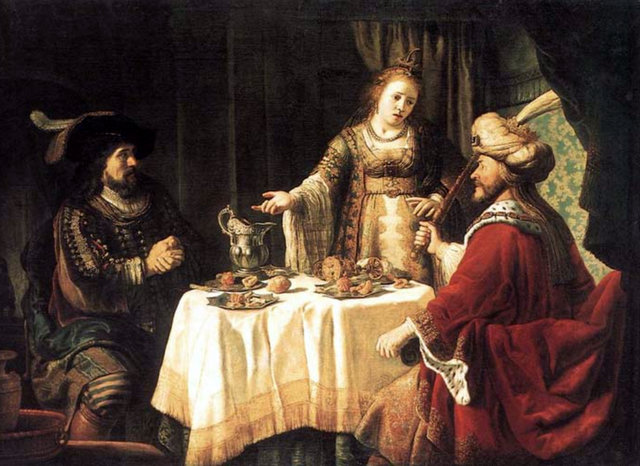
Purim is one of the most joyous and fun holidays on the Jewish calendar. It commemorates a time when the Jewish people living in Persia were saved from extermination.
The Book of Esther
The story of Purim is told in the Biblical book of Esther, with more details and commentary in the Talmud (Megillah). The heroes of the story are Esther, a beautiful young Jewish woman living in Persia, and her cousin Mordecai, who raised her as if she were his daughter. Esther was taken to the house of Ahasuerus, King of Persia, to become part of his harem. King Ahasuerus loved Esther more than his other women and made Esther queen, but the king did not know that Esther was a Jew because Mordecai told her not to reveal her identity.
The villain of the story is Haman, an arrogant, egotistical advisor to the king. Haman hated Mordecai because Mordecai refused to bow down to Haman, so Haman plotted to destroy the Jewish people. In a speech that is all too familiar to Jews, Haman told the king, “There is a certain people scattered abroad and dispersed among the peoples in all the provinces of your realm. Their laws are different from those of every other people’s, and they do not observe the king’s laws; therefore it is not befitting the king to tolerate them.” Esther 3:8. The king gave the fate of the Jewish people to Haman, to do as he pleased to them. Haman planned to exterminate all of the Jews. The word “Purim” means “lots” and refers to the lottery that Haman used to choose the date for the massacre.

Mordecai persuaded Esther to speak to the king on behalf of the Jewish people. This was a dangerous thing for Esther to do, because anyone who came into the king’s presence without being summoned could be put to death, and she had not been summoned. Esther fasted for three days to prepare herself, then went into the king. He welcomed her. Later, she told him of Haman’s plot against her people. The Jewish people were saved, and Haman and his ten sons were hanged on the gallows that had been prepared for Mordecai.
The book of Esther is unusual in that it is the only book of the Bible that does not contain the name of God. In fact, it includes virtually no reference to God. Mordecai makes a vague reference to the fact that the Jews will be saved by someone else, if not by Esther, but that is the closest the book comes to mentioning God. Thus, one important message that can be gained from the story is that God often works in ways that are not apparent, in ways that appear to be chance, coincidence or ordinary good luck.
Modern Echoes of Purim
The Pesach (Passover) seder reminds us that in every generation, there are those who rise up to destroy the Jewish people, but God saves them from their hand. In the time of the Book of Esther, Haman was the one who tried to destroy the Jews. In modern times, there have been two significant figures who have threatened the Jewish people, and there are echoes of Purim in their stories.
Many have noted the echoes of Purim in the Nuremberg war crime trials. In the Book of Esther, Haman’s ten sons were hanged (Esther 9:13); in 1946, ten of Hitler’s top associates were put to death by hanging for their war crimes, including the crime of murdering 6 million Jews. An 11th associate of Hitler, Hermann Göring, committed suicide the night before the execution, a parallel to the suicide of Haman’s daughter recorded in the Talmud (Megillah 16a). There are rumors that Göring was a transvestite, making that an even more accurate parallel. One of the men seems to have been aware of the parallel: on the way to the gallows, Julius Streicher shouted “Purim Fest 1946!” See: The Execution of Nazi War Criminals.
Another echo of Purim is found in the Soviet Union a few years later. In early 1953, Stalin was planning to deport most of the Jews in the Soviet Union to Siberia, but just before his plans came to fruition, he suffered a stroke and died a few days later. He suffered that stroke on the night of March 1, 1953, the night after Purim, and his plan to deport Jews was not carried out.
Purim Customs and Observances
Purim is celebrated on the 14th day of Adar, which is usually in March. The 13th of Adar is the day that Haman chose for the extermination of the Jews, and the day that the Jews battled their enemies for their lives. On the day afterwards, the 14th, they celebrated their survival. In cities that were walled in the time of Joshua, Purim is celebrated on the 15th of the month, because the book of Esther says that in Shushan (a walled city), deliverance from the massacre was not complete until the next day. The 15th is referred to as Shushan Purim.
The primary instruction related to Purim is to hear the reading of the book of Esther. God’s people are also encouraged to eat, drink and be merry and to send out gifts of food or drink, and to make gifts to charity. A common treat at this time of year is hamentaschen (lit. Haman’s pockets). These triangular fruit-filled cookies are supposed to represent Haman’s three-cornered hat.
It is customary to hold carnival-like celebrations on Purim, to perform plays and parodies, and to hold beauty contests. In America Purim is sometimes referred to as the Jewish Mardi Gras.
Purim is not subject to the sabbath-like restrictions on work that other holidays are, but some sources recommend not conducting ordinary business on Purim out of respect for the holiday.



